Graves Mountain is considered by many to be the "Mecca" of Georgia rockhounding
due to an incredible variety of minerals that may be collected there, including rutile,
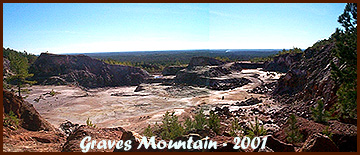 hematite, goethite, pyrophyllite, lazulite, variscite, pyrite, kyanite, quartz, and woodhouseite.
The rutile is hands-down the finest and largest in the world. Brilliantly colored iridescent hematite
can be found as a coating on many of the mine's rocks and minerals. Although Graves Mountain
once stood as the tallest and largest hill in the area, what remains after over two decades
of mining, are two large pits that are as deep and they once were high, with a small portion
of the highest eastern point still standing above it all. Separating the east and west pits is an
area referred to as the "saddle".
hematite, goethite, pyrophyllite, lazulite, variscite, pyrite, kyanite, quartz, and woodhouseite.
The rutile is hands-down the finest and largest in the world. Brilliantly colored iridescent hematite
can be found as a coating on many of the mine's rocks and minerals. Although Graves Mountain
once stood as the tallest and largest hill in the area, what remains after over two decades
of mining, are two large pits that are as deep and they once were high, with a small portion
of the highest eastern point still standing above it all. Separating the east and west pits is an
area referred to as the "saddle".
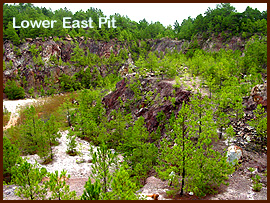
Although we have been to the mine literally dozens of times, Chrissy and I almost
never pass up an opportunity to dig there. So, after shooting the breeze with friends on Saturday morning,
we geared up and headed off toward the east pit. Although I usually carry all of our tools, buckets
and other gear with a hand cart, a thick accumulation of sticky mud caused by the previous day's
heavy rain made doing so impractical. We grabbed what tools we could carry and headed off toward
the generally less traveled east pit. Our rockhound, Opal, seemed to enjoy the wet conditions as
she ran ahead doing nothing to avoid splashing through the mud.
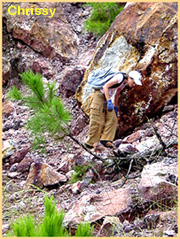
I had originally planned to walk around and prospect the mine due to a recurring
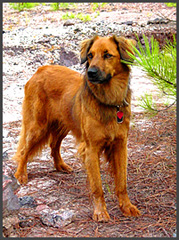 injury to my neck and upper back. I thought that maybe if I was to take a break from digging for
longer than 2 weeks, perhaps my injuries would have the proper time to heal. HA! It took me
all of about 5 minutes before I was swinging my mattock and stabbing a way at a portion of a wall
with my prybar. So much for healing that day! Of course, Chrissy was not surprised to look up
to see me digging away and she laughed and shook her head before moving on to do some actual
prospecting elsewhere in the east pit. When she wasn't confined by her leash, Opal spent her time
going back and forth between Chrissy and me.
injury to my neck and upper back. I thought that maybe if I was to take a break from digging for
longer than 2 weeks, perhaps my injuries would have the proper time to heal. HA! It took me
all of about 5 minutes before I was swinging my mattock and stabbing a way at a portion of a wall
with my prybar. So much for healing that day! Of course, Chrissy was not surprised to look up
to see me digging away and she laughed and shook her head before moving on to do some actual
prospecting elsewhere in the east pit. When she wasn't confined by her leash, Opal spent her time
going back and forth between Chrissy and me.
Chrissy came over to show me some fantastic green pyrophyllite that she had
found. Although white and beige colored pyrophyllite is relatively common at Graves Mountain, the
green variety is somewhat rare so that it was quite an excellent find - and, she had found a bunch
of it!
Click on each specimen picture above to enlarge
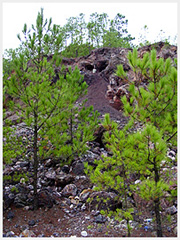
After poking around on several places and the steep high wall, I decided to pull
down an apron of rock and dirt that was blanketing a section near the top. By this time, Ron and
Faye Burke had made their way into the east pit and were working a section of the lower wall looking
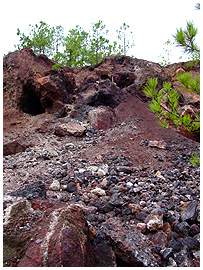 for goodies. After I dug down to the bedrock, I discovered a fairly large quartz vein. I decided
to follow it hoping that it would contain pockets with quartz crystals and goethite. Before too
long, I started to find relatively small pockets that contained mostly goethite and some small
quartz crystals that were covered in iridescent hematite. When Ron saw the good stuff that I was
finding, he asked me what made me dig in that particular spot. I would have liked to have claimed
that I had a premonition or that my finding this particular vein was due to my superior knowledge of the
Mountain. But the truth of the matter was that I simply did not know what prompted me to pick this
spot. I have a theory that my rockhounding success is like that of a squirrel hunting for acorns
that it buried months before. A squirrel doesn't remember where it buries its acorns, but if it
digs enough holes it will eventually find one. Like the lowly squirrel, I figure that if I dig
enough holes, I'm bound to find my own "acorns".
for goodies. After I dug down to the bedrock, I discovered a fairly large quartz vein. I decided
to follow it hoping that it would contain pockets with quartz crystals and goethite. Before too
long, I started to find relatively small pockets that contained mostly goethite and some small
quartz crystals that were covered in iridescent hematite. When Ron saw the good stuff that I was
finding, he asked me what made me dig in that particular spot. I would have liked to have claimed
that I had a premonition or that my finding this particular vein was due to my superior knowledge of the
Mountain. But the truth of the matter was that I simply did not know what prompted me to pick this
spot. I have a theory that my rockhounding success is like that of a squirrel hunting for acorns
that it buried months before. A squirrel doesn't remember where it buries its acorns, but if it
digs enough holes it will eventually find one. Like the lowly squirrel, I figure that if I dig
enough holes, I'm bound to find my own "acorns".
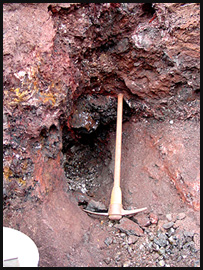
By the middle of the afternoon, I had recovered a minor pile of decent material
from a series of relatively small and spotty quartz pockets. I was satisfied with my take but kept
digging for the fun of it. My neck and back were not talking to me so far that day, so I decided
to take full advantage of their silence. I pried loose yet another chunk of quartz from the vein
to see what was behind it and lo and behold I looked down to see that I had removed the cap from
a very large pocket. Most pockets in the east pit are collapsed so that it can sometimes be
difficult to tell that you have hit one. The tell tale signs are loose rocks and crystals including
"floaters" of stalactitic goethite. If a pocket is large enough, it will look like a small cave
with piles of material on the bottom and some cave-like formations and quartz crystals protruding
from the sides and roof. The pocket that I had discovered was completely collapsed with little air
space. With great care, I was able to extract dozens of loose and attached quartz crystals and
a pile of botryoidal and stalactitic iridescent goethite/hematite specimens. Some of the more
noteworthy specimens can be seen on the following page.
Report continued . . . . . . .
Click Here for Next Page